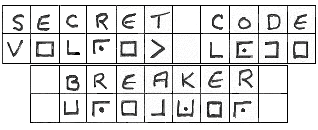Spying has been around for centuries. It's one of the world's most romanticized and dangerous jobs. Spying requires one to leave family and friends behind for weeks, months, and even years if they have to go undercover somewhere.
The United States has it's own CIA (Central Intelligence Agency) which has been shourded in conspirices and mystery for the general public. While most of us will never become a spy or agent, there are ways you can actually work for the CIA.
But today we are going to talk about secret codes, or just plain codes. I'll even provide examples and how to use some of them so you can make your own secret messages!
Common Codes Pictures at the bottom of post.
- American Sign Language- Okay so this isn't really code, but unless your deaf you won't know this unless you're just one of those people interested in this. In 1648, a man by the name of John Bulwar suggested that deaf people could learn to communicate with the use of their hands. A while later, George Dalgarno, a linguist and philosopher, created the first sign language complete with different letters and number by using only his hands. I've provided the alphabet here at the bottom of the post. ASL also has many signals hat represent whole ideas and words. You can even take classes to learn this!
- Morse Code- This code was invented by an American named Samuel F. B. Morse. The dots and dashes can stand for short and long sounds or light flashes. It was originally used for the telegraph machine. This is one of the msot popular hobbies for HAM radio operators who use morse code to talk to each other.
- Braille- This is writing system that allows the blind to read and write. Invented by a man named Louis Braille who himself was blind and then became a teacher for other blind people. Braille is in patterns of cells of six raised dots in a 3 x 2 rectangle. Each cell is either a letter, number, or punctuation mark. Perkin's School for the Blind is was the first school in the USA. It was established over 175 years ago and one of it's most famous students is Helen Keller. Samuel Gridley Howe perfected the mechanical braille typewriter and was the first director of Perkin's.
Other Codes
- Substitution Cipher- This is one of the oldest secret codes in the world. It was even used by Julius Ceaser! To make this code one simply substitutes one letter for another. For example, A could be B, B could be C, and so on.
- Alberti Cipher Wheel- In the fifteenth century, a man named Leon Battista Alberti invented a quicker way to make a substitution cipher. This device is simple and easy to make.
- Grid Ciphers- In this code, letters become numbers. To make one just arrange the alphabet into a 5 by 5 grid. So, a pair of numbers will become a letter. To read, start with the down column number first the use the according across number. In the one at the bottom, they used a 6 by 6 grid to inculde numbers. Here in the one provided, A = 11, b =12, and so forth.
- Pigpen Cipher- This one is one of the oddest but fun codes I've come across. Pigpen is quick because it's a grid that looks like a tic-tac-toe game with an X. Writing it is easy; each letter is represented by a part of the grid or the X that is surrounding it. If the letter you need is the second one in the box then the code represents it with a dot.
- Roman Numerals- Because few people actually take the time to learn how to read and write roman numerals past twelve, this can be turned into a code. For example: A = I, B = II, C = III, and so on so forth. (For more information on how to read and write Roman Numerals, see this post: http://birdsofawriter.blogspot.com/2011/05/how-to-read-and-write-in-roman-numerals.html)
Examples of Codes (Pictures and Links)
The American Sign Language: http://www.handspeak.com/
Morse Code: (Use the picture below to figure out) -.-. .- -. -.-- --- ..- .-. . .- -.. - .... .. ...?
For the Braille Alphabet: http://www.omniglot.com/writing/braille.htm
Grid:
Pigpen: (With Example Picture)
Link to the CIA site: https://www.cia.gov/
For more information on spying, codes, and whatnot, see Spy's Survival Handbook by Laban Carrick Hill. It's more of a little kids book, but it gives information and examples on spies, codes, and how to make your own ciphers and codes.
So, do you know of any more codes? Have you ever exchange letters with someone in secret code?
Sincerely,
Peony






No comments:
Post a Comment
Any comments with profanity or comments that are hurtful/ mean will be removed. We appreciate hearing your thoughts. Remember, if you wouldn't say it to someone's face please do not say it on the internet.